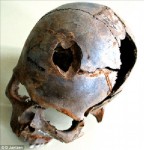 Archaeologists excavating on land and divers exploring the riverbed of the River Tollense valley of north-east Germany have uncovered what may be the remains of the earliest Bronze Age battlefield ever found. Evidence of human-on-human violence has been discovered as far back as the early Stone Age, but nothing indicating a large-scale battle between opposing factions. The finds on the River Tollense site include the remains of 100 bodies, most of them apparently young men, plus wooden bludgeoning weapons, an arrowhead embedded deep into an upper arm, and horse bones.
Archaeologists excavating on land and divers exploring the riverbed of the River Tollense valley of north-east Germany have uncovered what may be the remains of the earliest Bronze Age battlefield ever found. Evidence of human-on-human violence has been discovered as far back as the early Stone Age, but nothing indicating a large-scale battle between opposing factions. The finds on the River Tollense site include the remains of 100 bodies, most of them apparently young men, plus wooden bludgeoning weapons, an arrowhead embedded deep into an upper arm, and horse bones.
Some of the human skeletal remains show evidence of face-to-face combat — large unhealed holes in their head, for instance, that could have been inflicted by weapons like the two wooden clubs that were found in pieces on the site. One was a bat made of ash wood; the other looks similar to a croquet mallet and was made of sloe wood.

There is no evidence of formal burial, no pottery used as grave goods or paved stones used to build burial cysts, so archaeologists think the remains might have been washed downriver from the location of the primary battle.
The researchers suggest the bodies may have been dumped in the river before being washed away and deposited on a sandbar. Alternatively, the dead could have been killed on the spot in “the swampy valley environment”, the paper concludes.
[Dr Harald Lubke of the Centre for Baltic and Scandinavian Archaeology in Germany] believes the real conflict may have been fought out further up the river, and that the bodies so far found represent just a fraction of the carnage wrought by the battle.
“This is only a sample, what we have found up until now – the modern river bed only cuts across part of the river bed of that time. There are likely to be many more remains.
“It’s absolutely necessary to find the place where the bodies came into the water and that will explain if it really was a battle or something else, such as an offering, but we believe that a fight is the best explanation at the moment.”
The Tollense River valley at the time was the conjunction of several streams of the main tributary. It was settled, fertile, and an appealing territory for a foreign tribe to covet. The remains of a non-local millet diet found at the site could indicate the presence of an invading force.
The team’s findings thus far have been published in the journal Antiquity (pdf, subscription only), but the research is ongoing.